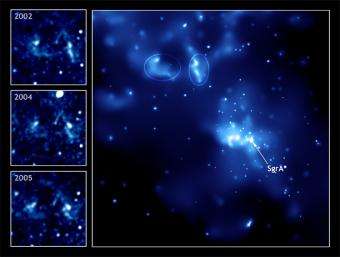Chandra Discovers Light Echo from the Milky Way's Black Hole

Like cold case investigators, astronomers have used NASA's Chandra X-ray Observatory to uncover evidence of a powerful outburst from the giant black hole at the Milky Way's center.
A light echo was produced when X-ray light generated by gas falling into the Milky Way's supermassive black hole, known as Sagittarius A* (pronounced "A-star"), was reflected off gas clouds near the black hole. While the primary X-rays from the outburst would have reached Earth about 50 years ago, the reflected X-rays took a longer path and arrived in time to be recorded by Chandra.
"This dramatic event happened before we had satellites in space that could detect it," said Michael Muno of the California Institute of Technology in Pasadena. "So, it's remarkable that we can use Chandra to dig into the past and see this monster black hole's capacity for destruction."
Previously, scientists have used Chandra to directly detect smaller and more recent outbursts from the black hole. This latest outburst revealed by the X-ray echo was about 1,000 times brighter and lasted well over 1,000 times longer than any of the recent outbursts observed by Chandra.
Theory predicts that an outburst from Sagittarius A* would cause X-ray emission from the clouds to vary in both intensity and shape. Muno and his team found these changes for the first time, thus ruling out other interpretations. The latest results corroborate other independent, but indirect, evidence for light echoes generated by the black hole in the more distant past.
Scientists have long known that Sagittarius A*, with a mass of about 3 million suns, lurked at the center for Milky Way. However, the black hole is incredibly faint at all wavelengths, especially in X-rays.
"This faintness implies that stars and gas rarely get close enough to the black hole to be in any danger," said co-author Frederick K. Baganoff of the Massachusetts Institute of Technology in Cambridge. "The huge appetite is there, but it's not being satisfied."
During the outburst, the area close to the black hole would have been about 100,000 times brighter than it is currently. If such an outburst had occurred more recently, it likely would have been detected by an X-ray instrument, or would have produced similar features in other nearby clouds.
"Our data show it has been 50 years or so since the black hole had its last decent meal," said Muno. "This is nothing like the feasting that black holes in other galaxies sometimes enjoy, but it gives unique knowledge about the feeding habits of our closest supermassive black hole."
The details of how Sagittarius A* feeds remain unclear. For example, one possibility is that the black hole grows by pulling in matter from the winds of nearby young stars. Also, if there is a disk of material swirling around Sagittarius A*, it might be unstable in such a way that material migrates toward the black hole's edge in clumps, emitting X-rays before disappearing from the universe forever. The theoretical work is still being developed.
Studying this light echo is also important because it illuminates and probes the poorly understood molecular clouds near the center of the galaxy. In particular, it gives information about the dense cores of these clouds where new stars may be forming.
Variability in the X-ray emission between three Chandra observations in 2002, 2004 and 2005 argues against an alternate source for the light echo, which is that it came from a neutron star or black hole pulling matter away from a binary companion. This explanation is not favored because the data show the outburst would have been unusually long and bright for such a binary.
These results were presented at the American Astronomical Society meeting in Seattle, Wash., and will appear in an upcoming issue of The Astrophysical Journal Letters. NASA's Marshall Space Flight Center, Huntsville, Ala., manages the Chandra program for the agency's Science Mission Directorate. The Smithsonian Astrophysical Observatory controls science and flight operations from the Chandra X-ray Center, Cambridge, Mass.
Source: Chandra X-ray Center



















